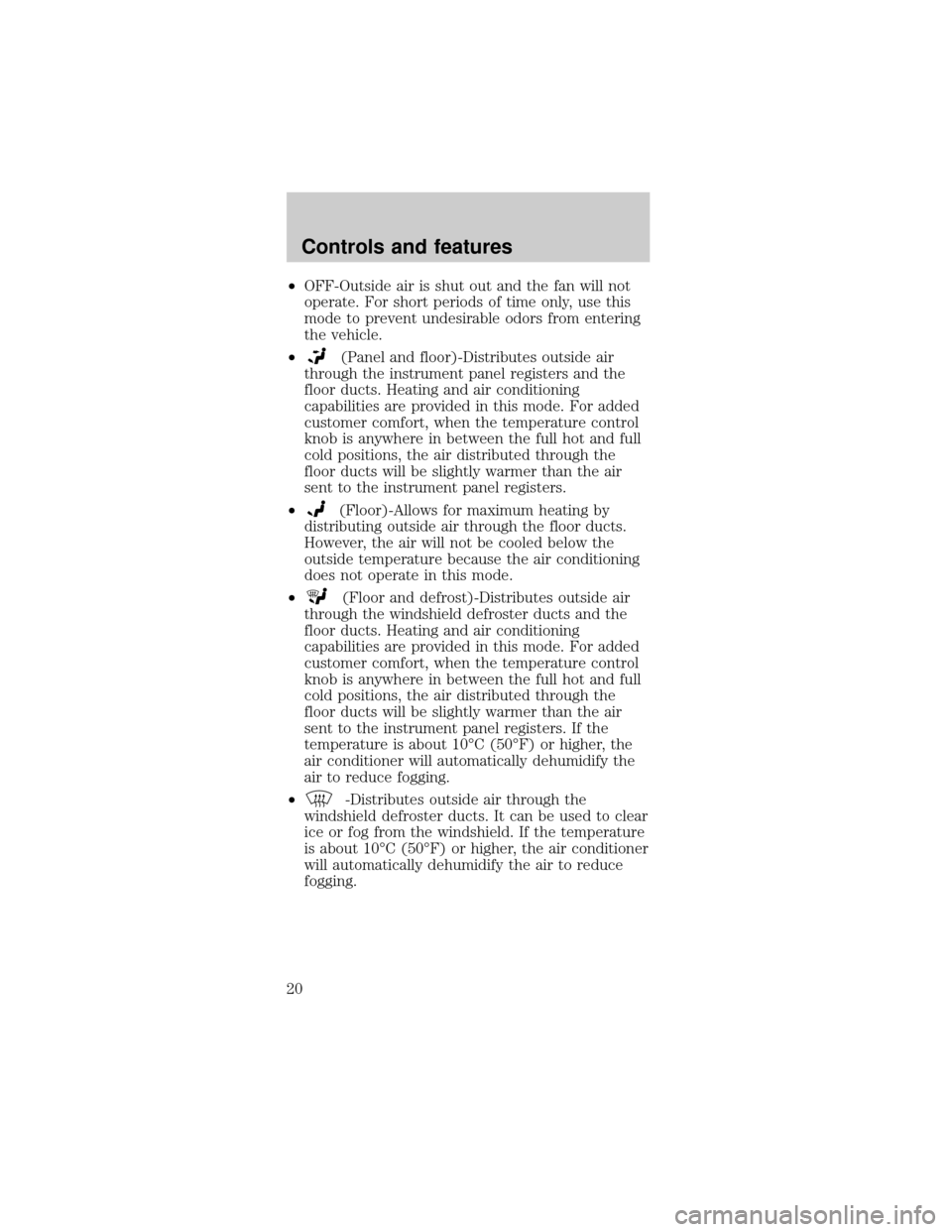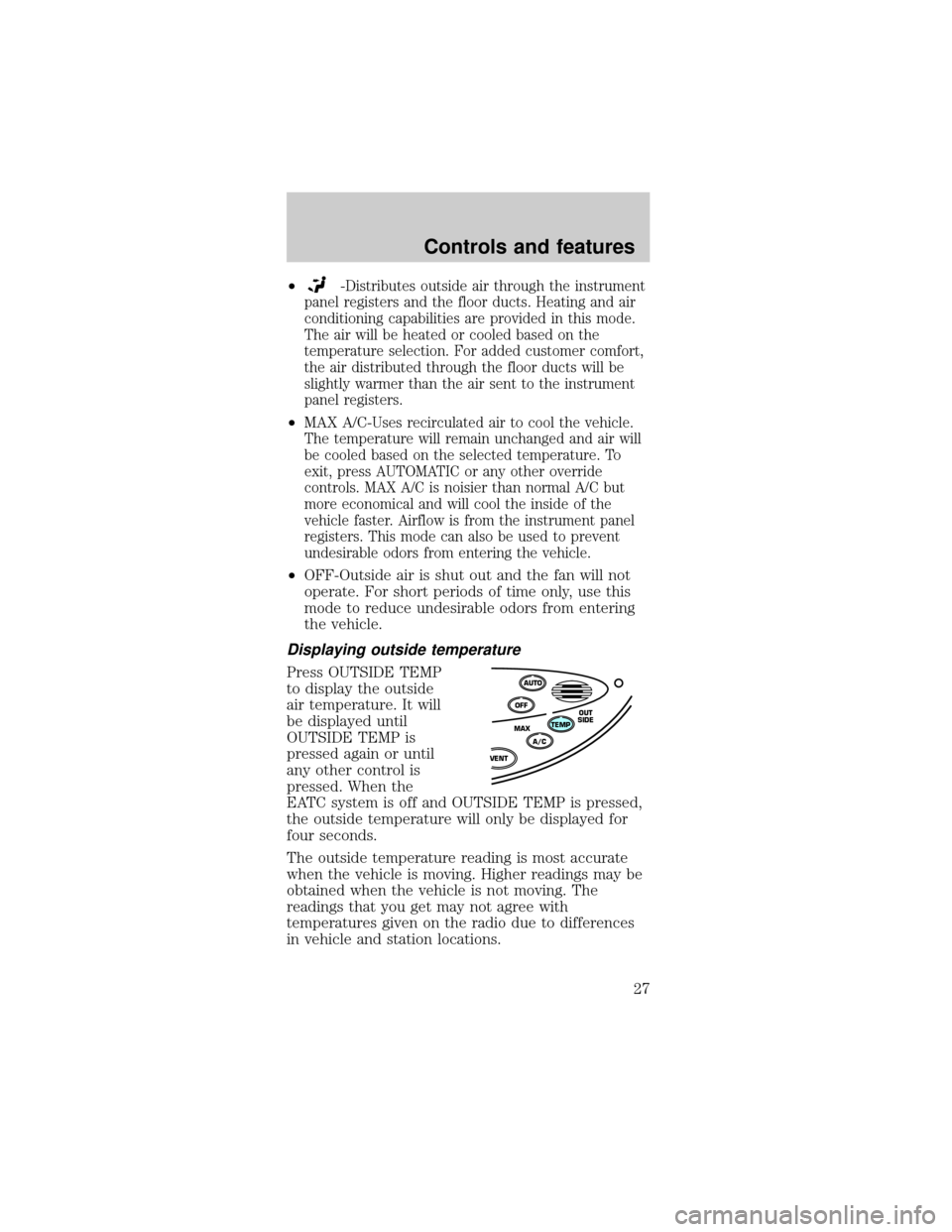Page 17 of 224
Flash to pass
Pull toward you to
activate and release to
deactivate.
PANEL DIMMER CONTROL
Use to adjust the
brightness of the
instrument panel
during headlamp and
parklamp operation.
²Rotate up to
brighten.
²Rotate down to dim.
²Rotate to full up position (past detent) to turn on
interior lamps.
AUTOLAMP CONTROL
The autolamp system
provides light sensitive
automatic on-off
control of the exterior
lights normally
controlled by the
headlamp control.
The autolamp system also keeps the lights on for a
preselected period of time after the ignition switch
is turned to OFF.
PPANEL
DIMAUTO
LAMP
PPANEL
DIMAUTO
LAMP
Controls and features
17
Page 18 of 224
²To turn autolamps on, rotate the control up. The
preselected time lapse is adjustable up to
approximately three minutes by continuing to
rotate the control upward.
²To turn autolamps off, rotate the control down
until it clicks.
REAR WINDOW DEFROSTER
Clears the rear window of thin ice and fog. To
operate:
1. Turn the ignition to the ON position.
2. Press and release
the control once to
turn on. The light will
be lit while the rear
window defroster is on.
3. Press and release the control again to turn off.
The defroster will automatically turn off after fifteen
minutes.
CLIMATE CONTROL SYSTEM
Manual heating and air conditioning system
(if equipped)
Fan speed control
Controls the volume of
air circulated in the
vehicle.
R-DEF
R-DEF
LO
HIOFF
A/C
MAX
A/CVENT
LO
HI
Controls and features
18
Page 20 of 224

²OFF-Outside air is shut out and the fan will not
operate. For short periods of time only, use this
mode to prevent undesirable odors from entering
the vehicle.
²
(Panel and floor)-Distributes outside air
through the instrument panel registers and the
floor ducts. Heating and air conditioning
capabilities are provided in this mode. For added
customer comfort, when the temperature control
knob is anywhere in between the full hot and full
cold positions, the air distributed through the
floor ducts will be slightly warmer than the air
sent to the instrument panel registers.
²
(Floor)-Allows for maximum heating by
distributing outside air through the floor ducts.
However, the air will not be cooled below the
outside temperature because the air conditioning
does not operate in this mode.
²
(Floor and defrost)-Distributes outside air
through the windshield defroster ducts and the
floor ducts. Heating and air conditioning
capabilities are provided in this mode. For added
customer comfort, when the temperature control
knob is anywhere in between the full hot and full
cold positions, the air distributed through the
floor ducts will be slightly warmer than the air
sent to the instrument panel registers. If the
temperature is about 10ÉC (50ÉF) or higher, the
air conditioner will automatically dehumidify the
air to reduce fogging.
²
-Distributes outside air through the
windshield defroster ducts. It can be used to clear
ice or fog from the windshield. If the temperature
is about 10ÉC (50ÉF) or higher, the air conditioner
will automatically dehumidify the air to reduce
fogging.
Controls and features
20
Page 26 of 224

Since the air conditioner removes considerable
moisture from the air during operation, it is normal
if clear water drips on the ground under the air
conditioner drain while the system is working and
even after you have stopped the vehicle.
Under normal conditions, your vehicle's climate
control system should be left in any position other
than MAX A/C or OFF when the vehicle is parked.
This allows the vehicle to ªbreatheº through the
outside air inlet duct. Prior to turning off the
ignition in snowy or dirty conditions, ensure that the
climate control system is turned off.
²F
-Distributes outside air through the
windshield defroster ducts. It can be used to clear
ice or fog from the windshield. If the outside air
temperature is about 10ÉC (50ÉF) or higher, the
air conditioner will automatically dehumidify the
air to reduce fogging.
²
-Distributes outside air through the
windshield defroster ducts and the floor ducts.
Heating and air conditioning capabilities are
provided in this mode. The air will be heated or
cooled based on the temperature selection. For
added customer comfort, the air distributed
through the floor ducts will be slightly warmer
than the air sent to the windshield defroster
ducts. If the temperature is about 10ÉC (50ÉF) or
higher, the air conditioner will automatically
dehumidify the air to reduce fogging.
²
-Allows for maximum heating by distributing
outside air through the floor ducts. However, the
air cannot be cooled below the outside
temperature because the air conditioning does not
operate in this mode.
²
-Distributes outside air through the
instrument panel registers. However, the air
cannot be cooled below the outside temperature
because the air conditioning does not operate in
this mode.
Controls and features
26
Page 27 of 224

²-Distributes outside air through the instrument
panel registers and the floor ducts. Heating and air
conditioning capabilities are provided in this mode.
The air will be heated or cooled based on the
temperature selection. For added customer comfort,
the air distributed through the floor ducts will be
slightly warmer than the air sent to the instrument
panel registers.
²MAX A/C-Uses recirculated air to cool the vehicle.
The temperature will remain unchanged and air will
be cooled based on the selected temperature. To
exit, press AUTOMATIC or any other override
controls. MAX A/C is noisier than normal A/C but
more economical and will cool the inside of the
vehicle faster. Airflow is from the instrument panel
registers. This mode can also be used to prevent
undesirable odors from entering the vehicle.
²OFF-Outside air is shut out and the fan will not
operate. For short periods of time only, use this
mode to reduce undesirable odors from entering
the vehicle.
Displaying outside temperature
Press OUTSIDE TEMP
to display the outside
air temperature. It will
be displayed until
OUTSIDE TEMP is
pressed again or until
any other control is
pressed. When the
EATC system is off and OUTSIDE TEMP is pressed,
the outside temperature will only be displayed for
four seconds.
The outside temperature reading is most accurate
when the vehicle is moving. Higher readings may be
obtained when the vehicle is not moving. The
readings that you get may not agree with
temperatures given on the radio due to differences
in vehicle and station locations.
OFFAUTO
TEMPOUT
SIDE
A/C MAX
VENT
Controls and features
27
Page 38 of 224
²The treble adjust
control allows you to
increase or decrease
the audio system's
treble output.
Speaker balance/fade adjust
²Speaker sound
distribution can be
adjusted between
the right and left
speakers.
²Speaker sound can
be adjusted between
the front and rear
speakers.
Inserting a tape
Push only slightly when
inserting a cassette
tape (with the open
edge to the right). A cassette deck loading
mechanism pulls the tape in the rest of the way.
You can switch from CD to tape play by inserting a
tape into the cassette deck.
Tape/CD select
²To begin tape play
(with a tape loaded
into the audio
system) while in the
BASS
TREB
BAL
FADE
BASS
TREB
BAL
FADE
BASS
TREB
BAL
FADE
DOLBY B ®TAPECDEJECT
TAPECD
Controls and features
38
Page 43 of 224

²The disc is dusty or defective.
²The player's internal temperature is above 60ÉC
(140ÉF). Allow the player to cool down before
operating.
²A disc with format and dimensions not within
industry standards is inserted.
Cleaning compact discs
Inspect all discs for contamination before playing. If
necessary, clean discs only with an approved CD
cleaner and wipe from the center out to the edge.
Do not use circular motion.
CD and CD changer care
²Handle discs by their edges only. Never touch the
playing surface.
²Do not expose discs to direct sunlight or heat
sources for extended periods of time.
²Do not insert more than one disc into each slot of
the CD changer magazine.
Cleaning cassette player (if equipped)
Clean the tape player head with a cassette cleaning
cartridge after ten to twelve hours of play in order
to maintain the best sound and operation.
Cassette and cassette player care
²Use only cassettes that are 90 minutes long or
less.
²Do not expose tapes to direct sunlight, high
humidity, extreme heat or extreme cold. Allow
tapes that may have been exposed to extreme
temperatures to reach a moderate temperature
before playing.
²Tighten very loose tapes by inserting a finger or
pencil into the hole and turning the hub.
²Remove loose labels before inserting tapes.
Controls and features
43
Page 44 of 224

²Do not leave tapes in the cassette player for a
long time when not being played.
Radio frequency information
The Federal Communications Commission (FCC)
and the Canadian Radio and Telecommunications
Commission(CRTC) establish the frequencies AM
and FM stations may use for their broadcasts.
Allowable frequencies are:
AM 530, 540±1600, 1610 kHz
FM 87.9, 88.1±107.1, 107.9 MHz
Not all frequencies are used in a given area.
Radio reception factors
Three factors can affect radio reception:
²Distance/strength.The further an FM signal
travels, the weaker it is. The listenable range of
the average FM station is approximately 40 km
(24 miles). This range can be affected by ªsignal
modulationº. Signal modulation is a process radio
stations use to increase their strength/volume
relative to other stations.
²Terrain.Hills, mountains and tall buildings
between your vehicle's antenna and the radio
station signal can cause FM reception problems.
Static can be caused on AM stations by power
lines, electric fences, traffic lights and
thunderstorms. Moving away from an interfering
structure (out of its ªshadowº) returns your
reception to normal.
²Station overload.Weak signals are sometimes
captured by stronger signals when you pass a
broadcast tower. A stronger signal may
temporarily overtake a weaker signal and play
while the weak station frequency is displayed.
The audio system automatically switches to single
channel reception if it will improve the reception of
a station normally received in stereo.
Controls and features
44